Novel NMR Probe Technologies, GHz-class NMR and Dynamics Software Enable New Research, and Advance Functional Structural Biology and Drug Discovery
BOSTON–(BUSINESS WIRE)–
At the ICMRBS 2022 Conference, Bruker today announces a new 8 mm 15N TROSY Cryoprobe for enabling novel NMR functional structural biology investigations into larger globular proteins and protein complexes. The new technology also facilitates cell biology research into highly dynamic intrinsically disordered proteins (IDPs) or protein regions that often play key roles in signaling pathways via phosphorylation, e.g. in cancer. The new 8 mm 15N TROSY Cryoprobe provides twice the sensitivity of previous 5 mm detection, and 50% greater 13C sensitivity at 800 MHz. It allows researchers to obtain essential information in crowded IDP spectral regions for the unambiguous assignment of IDP backbone resonances.

Compact 1.0 GHz NMR magnet Ascend Evo for structural biology applications and clinical research in single-story laboratories (Graphic: Business Wire)
Dr. Haribabu (‘Hari’) Arthanari, Associate Professor in the Department of Biological Chemistry and Molecular Pharmacology at Harvard Medical School, and in the Department of Cancer Biology at the Dana-Farber Cancer Institute, stated: “We can now greatly expand the scientific scope of functional structural biology by high-field NMR with 15N-detected experiments to study non-deuterated protein systems, like disordered proteins or globular proteins, which can now be made in flexible eukaryotic expression systems. The new 8mm 15N TXO Cryoprobe holds promise to unleash the power of 15N-detection at high fields. I am very excited to see which previously inaccessible but important scientific and pathobiology questions this innovative NMR technology can address.”
Bruker also announces the technology introduction of a novel 160 kHz Ultra-fast spinning Magic Angle Spinning (MAS) NMR probe for advancements in solid-state membrane protein, prion, and aggregates research. This new probe, which mechanically spins 160,000 times per second, provides a further significant resolution increase, and can record solids HCN NMR spectra in just tens of minutes. The significantly increased new capabilities of this 160 kHz 0.4mm MAS probe at high NMR fields may enable novel insights and discoveries in neurodegenerative diseases, like Parkinson’s and Alzheimer’s, and in other cell and disease biology fields.
Dr. Guido Pintacuda, CNRS Research Director and Director of the Lyon High-field NMR Center explained: “The new Bruker 160 kHz MAS HCN probe will push structural, cellular and disease biology research into the next phase of the solid-state NMR scientific evolution. Not only will this expand the diversity and molecular size range of biological systems such as membrane proteins, amyloid fibrils, prions, and aggregates amenable for analysis by solid-state NMR, but it will accelerate their investigation and increase the amount of information that can be extracted from these important biological systems.”
Bruker is also very pleased to announce the installation and acceptance of the 1.2 GHz Avance™ NMR at University of Lille in France, which will be a part of the national infrastructure INFRANALYTICS. This first 1.2 GHz NMR in France will allow researchers in Lille, and from all over France, to advance their understanding of functional structural biology and advanced materials.
Professor Jean-Pierre Simorre, Research Director, and Deputy Director INC at CNRS, commented: “We are thrilled to have received our 1.2 GHz NMR system. The power and resolution of 1.2 GHz will provide the unique ability to study proteins in their natural state and examine their structural details, including binding and dynamics of molecular structures and complexes, for our fundamental cell biology and pathobiology research.”
Professor Olivier Lafon at the University of Lille, and Director of Lille High-Field NMR Facility, expanded: “The 1.2 GHz NMR spectrometer will strongly improve the sensitivity and resolution for quadrupolar isotopes, such as 14N, 17O, 25Mg, 33S, 63Cu, and 67Zn, in materials and solid-state biomolecules. This will notably open new avenues for the study of dynamics, hydrogen bonds, disulfide bonds and metal centers of many metalloproteins, nucleic acids and carbohydrates.”
Moreover, as announced at Euromar 2022, Bruker has received three orders for compact 1.0 GHz NMR systems from the RIKEN Center for Biosystems Dynamics Research in Yokohama, Japan, the Precision Medicine and Metabolism Lab at CIC bioGUNE, and the BioNMR Group at Universitat de Barcelona, both in Spain. The Ascend Evo 1.0 GHz NMR magnet utilizes hybrid high temperature superconductor (HTS) technology for operation at 4.2 Kelvin in single-story labs. The significantly reduced footprint, weight, and ceiling height, along with a 65% reduction in helium consumption, provides more structural biology principal investigators, universities, and research centers, as well as biopharma companies access to the sensitivity and resolution of GHz NMR. The 1.0 GHz system complements Bruker’s well-established Avance Neo 1.1 GHz and 1.2 GHz two-story 2 Kelvin NMR systems.
Bruker now offers combined bioTop and DynamicsCenter software to simplify and automate experimental setup, measurements, and processing for protein dynamics analysis. DynamicsCenter combines NMR assignments with 3D protein structures imported from crystallography or cryo-EM.
Please join Bruker at ICMRBS at our booth for interaction with our NMR and EPR teams.
About Bruker Corporation (Nasdaq: BRKR)
Bruker is enabling scientists to make breakthrough discoveries and develop new applications that improve the quality of human life. Bruker’s high performance scientific instruments and high value analytical and diagnostic solutions enable scientists to explore life and materials at molecular, cellular and microscopic levels. In close cooperation with our customers, Bruker is enabling innovation, improved productivity and customer success in life science molecular and cell biology research, in applied and pharma applications, in microscopy and nanoanalysis, as well as in industrial applications. Bruker offers differentiated, high-value life science and diagnostics systems and solutions in preclinical imaging, clinical phenomics research, proteomics and multiomics, spatial and single-cell biology, functional structural and condensate biology, as well as in clinical microbiology and molecular diagnostics. For more information, please visit: www.bruker.com.
Source: Bruker Corporation





